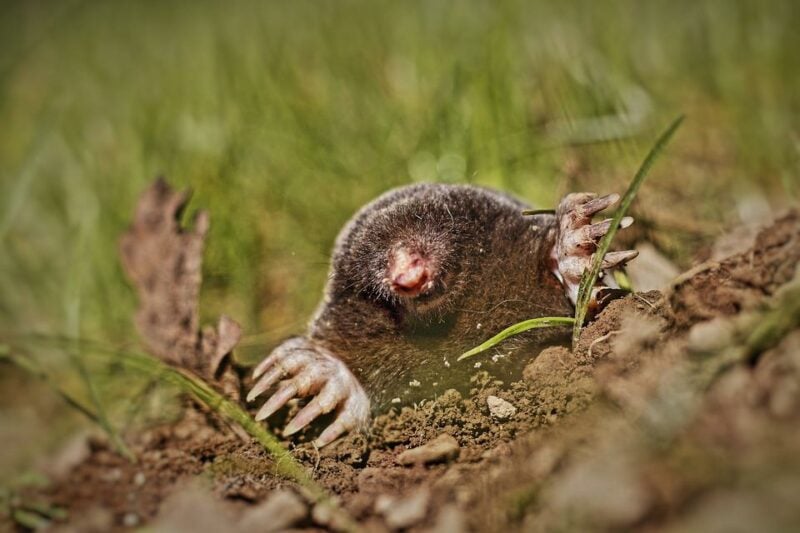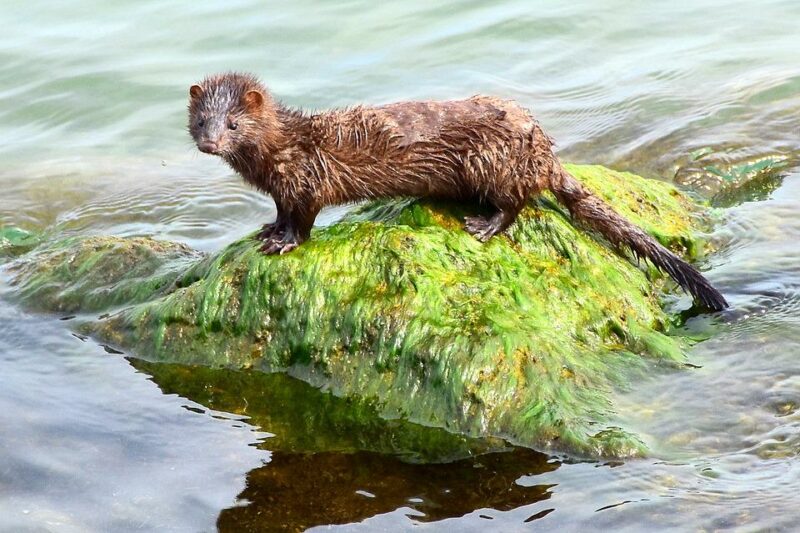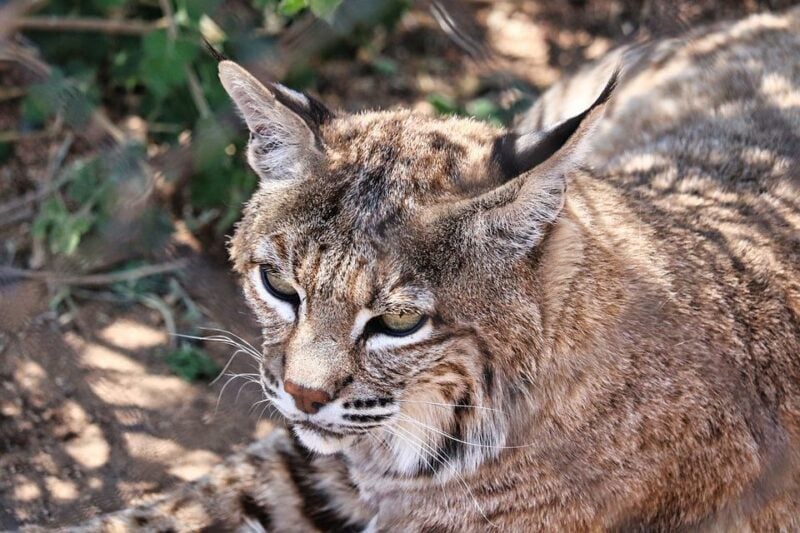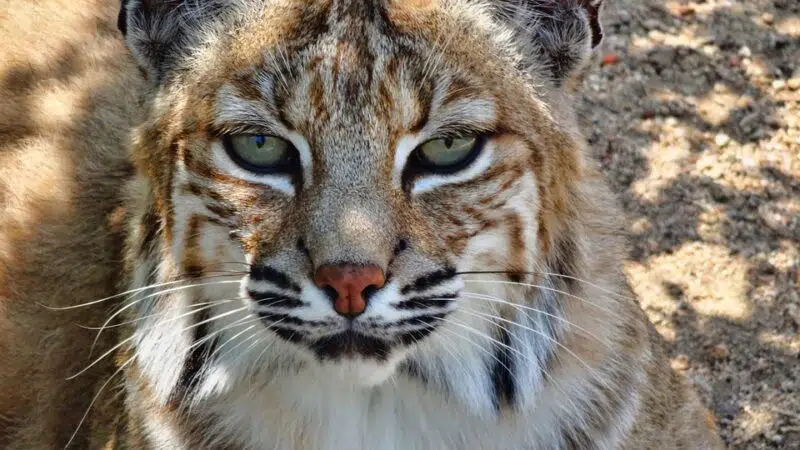Missouri offers a great variety of animals, wildlife, and nature. Many animals live in the dense forests of the midwestern state.

Click below to jump to any section on animals in Missouri.
Wildlife in Missouri
Missouri is home to rodents like woodrats, voles, dark eastern squirrels, eastern chipmunks, groundhogs, flying squirrels, and pocket gophers. Shrews look like mice in physical appearance, and they are not counted as rodents. Northern and southern tiny-tailed shrews are primarily found in Missouri.
American buffalo were reintroduced into Missouri after being almost being hunted to extinction. They can be easily found in Prairie State Park. Other giant warm-blooded creatures are elk and white deer, including mountain elk, were also reintroduced into the state. This massive herbivore is now found in Prairie State Park in Barton County.
Wolves were eliminated from Missouri; now the top hunter is the coyote, then red and gray foxes, and bobcats.
Cougars are sometimes found around the state, but not commonly. The Black colored bear is considered the largest mammalian predator, but will mostly eat only plant material. American minks, different types of weasels, North American river otters, opossums, and Eastern striped skunks are other mammals found in Missouri.
The Mexican bat is the most common Chiroptera mammal, among other species of bats in Missouri. Different types of rabbits are also found in Missouri, where the armadillo has been introduced to the state.
Muskrat

The muskrat is a vigorous vole weighing up to 1.8 kg. It has short legs and a more petite body, up to 33 cm long. The meagerly-haired textured tail is straightened upward and can be as long as the body. The eyes are little, and the ears are almost hidden by fur, ranging from rosy to blackish brown, and comprise a short, delicate underfur intensely overlaid with long, firm, shiny watchman hairs.
The thick underfur traps air, giving both protection and lightness. Muskrats‘ enormous rear feet, bordered with solid fibers and, to some extent, webbed, are utilized as paddles while swimming, with the tail filling in as a rudder. They can remain lowered for 20 minutes and swim as quickly as 5 km each hour.
The creature is named for the musky smell of a yellowish substance delivered by its perineal organs. Emitted into the pee, the meaning is utilized to stamp hotels, pathways, and different tourist spots throughout a singular’s home reach.
Bogs are the traditional territory of muskrats, yet they likewise live in lush marshes, lakes, and streams, where they fabricate sizable cabins of sedges, cattails, and other vegetation. They additionally dig tunnels close to the water’s edge for cover, and their tunneling sometimes debilitates earthen dams and barriers.
Eating, for the most part, grasses and cattails, muskrats drink the roots and stalks of a wide assortment of other amphibian plants; they are, in any case, at times savage, taking freshwater snails, mussels, scavengers, fish, lizards, and youthful birds for food. Females produce at least one litter of three to eight young every year after a development time of three to about a month.
Where can one find Muskrat in Missouri?
Muskrats are rarely viewed as distant from water and lean toward the still or sluggish water of bogs, lakes, and streams. They are dynamic consistently; generally, nighttime may move during sunshine hours.
In Missouri, muskrats typically live in houses worked of vegetation or in tunnels dove into lakes or stream banks. The houses and underpasses have submerged passages or more water-residing chambers. Muskrats likewise usually possess deserted beaver cabins or bank nooks.
Eastern Mole

A little, bold, smoothed-out warm-blooded creature with covered ears, minuscule eyes, and a beefy, mobile nose. The smooth fur is grayish-earthy colored above and gleaming dark underneath. The wide front feet are broadened, have huge paws, and point outward to support digging underground passages.
They have a short tail, which is insufficiently furred. Nightcrawlers and grubs are a traditional food; additionally, centipedes, bugs, subterranean insects, and different spineless creatures. Some plant food varieties are eaten as well.
The Eastern Mole, like different moles, has a solitary litter yearly. Mating starts in pre-spring or late winter, followed by a pregnancy of 4 a month and a half. In the spring, a waste of 2-5 (standard 4) youthful is brought into the world in the underground home chamber, which is fixed with roots, leaves, or grass. Infant moles are visually impaired and almost bare. Youthfulness is weaned following a month of fast development.
Little is had some significant awareness of the mating arrangement of Eastern moles. Mating is from February to March. They construct homes from grasses, leaves, and portions of plants in a tunnel under a stone, log, or stump. Growth is ordinarily for 45 days, and a litter of two to five is brought into the world between mid-April and June. The youth can be brought into the world in March in warm environments. They are visually impaired, bare, and moderately enormous when conceived, contrasted in size and their mom.
At ten days old, they have a light-dim fine, smooth fur, which goes on for quite some time. Quick development implies they can leave home and search for themselves at around a month old. Eastern moles are little warm-blooded animals with smooth dark fur, a thin sharp nose, small eyes, enormous front paws, scoop-formed for digging, and short bare tails.
It is a clandestine creature and seldom seen, yet it leaves clear indications of its action – hills of unearthed soil (molehills or “push-ups“) – and raised earth burrows that it works in nurseries, yards, and fields. They have no outer ears or eyes; however, their ineffectively evolved eyes can identify the light. One person in bondage lived for longer than three years; however, in the wild, it is believed that they live for less.
Where can one find Eastern mole in Missouri?
One can easily find an eastern mole in Missouri. They live in pastures, fields, meadows, and open woodland.
American Mink

These animals in Missouri are one of the significant sources of fur business, and people used to jail them for fur business as in those days, they used to survive on this trade business. They are wild animals tiny in size.
They are notorious, primarily found at night and near water areas. Wherever you find, there are chances you can see American mink. They are around 30 – 50 cm long, their tail is about 13 – 23 cm long, and they weigh about 2kg or sometimes less based on their food and diet.
Females have different lengths and weights than male mink. They have tiny legs with thick and long necks like weasels. Their ears are shot, and they have a broad head. Their back is full of heavy fur, and it’s brown with white color marks on under areas.
Wild mink is semiaquatic and acquires most of their food near the water’s edge. Following coastlines and banks, they commonly explore openings, holes, and deep water pools for buried prey. Stringently predatory, mink generally eat frogs, lizards, fish, crawfish, muskrats, mice, and voles, alongside amphibian birds and their eggs. Infrequently, mink will look for earthbound prey like bunnies and hares.
Mink are solid and lithe swimmers and frequently plunge to test submerged little hiding spots. Minks prefer to live single but mate during the spring season and can mate with others. But females’ mink used to grow the baby mink on their own.
American mink brought up in imprisonment for fur are reproduced during late winter, and reap of pelts happens when the creatures arrive at the grown-up size and the coat is at most extreme quality-as a rule, during winter when mink are 6-8 months old. During this period, farm mink arrives at sizes that might surpass double that of wild mink due to better sustenance and particular rearing for size.
Likewise, through specific rearing and cautious hereditary development, raisers can deliver various regular pelage tones, going from pure white to sapphire, pearl, blue, and dark.
Where can one find American mink in Missouri?
The American mink is found in Missouri in wetlands, rivers, marshlands, and coastal areas.
Bobcat

These animals in Missouri are long-legged feline with giant paws, a reasonably short body, and tufted ears; the wildcat is 60-100 cm long, barring the 10-20-cm tail, stands 50-60 cm at the shoulder, and weighs 7-15 kg. Its fur, stiffer and less significant than the lynx’s, is pale brown to rosy with dark spots. The underparts are white; the tip of the tail is dark above and white beneath.
In some cases found in rural regions, the wildcat is nighttime, for the most part, a single feline. Similarly, it is less disposed of at home in woods and deserts than the lynx to climb trees or swim. It benefits rodents, bunnies, rabbits, and a few birds.
Reproducing happens in spring (now and again a second time later in the year); a litter of one to six cats is brought into the world after a growth time of around 50 days. Financially, the catamount is valuable as a furbearer and is significant in keeping the quantities of rodents and bunnies taken care of.
The wildcat is a nighttime and lone creature, the most dynamic covert of night, and tends to do most of its hunting during first light and nightfall. In the daytime, wildcats rest and rest in a nook which could be an empty tree or a stone cleft, with one individual involving various lairs in its home reach.
These felines are exceptionally regional and will check their reach with fragrance and make unmistakable tree hook markings to tell others of their presence. The guys have an enormous space, frequently covering a few more modest female regions. However, felines won’t collaborate until the reproducing season in the winter time of year.
During the remainder of the year, catamounts keep away from each one more to limit the gamble of being harmed during a battle. The catamount scarcely at any point expresses, even though it frequently yowls and murmurs during the mating season.
Where can one find Bobcats in Missouri?
Bobcats include boreal coniferous and mixed forests in the North, coastal swamps in the southeast, bottomland hardwood forests, and desert and scrublands in the southwest.
Deer Mouse

They have protruding eyes and gigantic ears, weigh 15 to 110 grams, and are 8 to 17 cm long. The tail might be more limited than the head and body or strikingly longer, contingent upon the species. All deer mice have delicate fur, yet variety fluctuates between and inside species. The skin is almost white in specific populations of cotton mice in the southeastern United States. Yet, it can go from dim to dazzling buff, brown, ruddy brown, and blackish, which possesses the mountain woodlands of southern Mexico.
Species residing in dull and wet backwoods often have dim coats, while those adjusted to deserts and grasslands are primarily pale; all have white feet. Deer mice are nighttime yet are incidentally dynamic in the afternoon. They spend golden hours in tunnels or trees, building homes of plant material. Albeit earthly, they are deft climbers. Their eating routine incorporates everything, from plant items and growths to spineless creatures and remains.
It is sometimes called the white-footed mouse and has the broadest geographic circulation of any North American rat. Found from Canada to subtropical Mexico, it lives in a staggering scope of natural surroundings between the Canadian tundra and the Sonoran Desert; it likewise lives in calm and boreal timberlands, fields, and clean developments.
Females produce up to four litters each year following 21 to 27 days of incubation, and each junk mainly contains three to five youthful (one to eight are limits). In the mid-21st 100 years, a few developmental scholars stated that the variety of changes happening in the fur of a populace of P. maniculatus was perhaps the perfect illustration of regular determination.
Research suggests that a quality related to lighter-shaded fur, nicknamed Agouti by researchers, usually arose somewhere in the range of 8,000 and 15,000 quite a while back in some deer mice that occupied a remarkable sand ridge climate in Nebraska, U.S. This transformation permitted a few mice to disguise themselves against the sand-hued foundation of the ridges more readily.
It is believed that north of thousands of ages, the recurrence of the Agouti quality expanded in this populace while the reproduction of the quality related to hazier fur declined. A few researchers battle that the various changes happening in deer mice might act as a more helpful illustration of everyday choice in real life than the nineteenth-century variety change seen in peppered moths (Biston betularia) in England that was ascribed to modern melanism.
Where to find Deer Mice in Missouri:
They are mostly found living in woodland areas and in desert areas alongside other animals in Missouri.
Summary Animals in Missouri
Animals in Missouri: Missouri is a sanctuary for birds that has different types of lakes, streams, waterways, and freshwater lakes. Their ducks, geese, swans, and birds, which swim, are like herons and egrets. Woodrats and voles are the other rodents; dark eastern squirrels, eastern chipmunks, groundhogs, flying squirrels, and pocket gophers are some more animals in Missouri.
Shrews look like mice in physical appearance. They are not counted as rodents but still belong to the Soricidae family. Northern and southern tiny-tailed shrews are primarily found in Missouri. It is a vast herbivore and can be easily found in Prairie State Park.
Other giant warm-blooded creatures are elk and white deer, including mountain elk, also introduced in the state. This colossal herbivore is now found in Prairie State Park in Barton County. The other enormous warm-blooded creatures are white-followed deer and elk, including the Rocked Mountain elk, which was brought into the state.
Wolves were eliminated from Missouri, but the top strong-teeth hunter is presently the coyote, and after that comes the red and gray foxes. Bobcat is also the most critical predator found in Missouri.
Cougar is found to be moving all around the state but still counted as wholly eliminated. The Black colored bear is considered the largest mammalian predator compared to other predators in Missouri but is found to eat only plant material mostly. A large number of animals are found in Habitats of Missouri.
To continue reading about North America, check out animals in Antarctica and New Jersey next!
- Top 10 Cutest Fish in the World - April 15, 2024
- 10 Most Endangered Animals - April 15, 2024
- 16 Top Predators in the Food Chain - April 12, 2024



